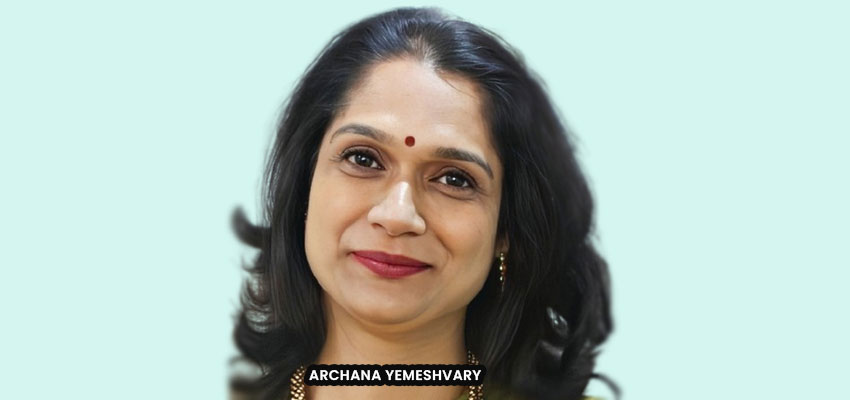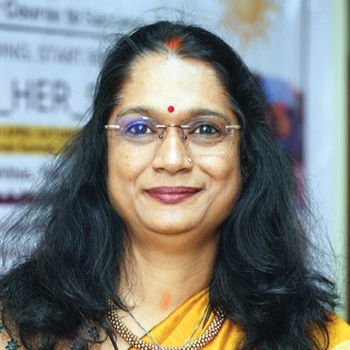Workplace Equity A Journey of Inclusion and Leadership

Avtar, one of India's premier workplace culture consulting firms, brought together women professionals, industry leaders, and change-makers under the theme #AdvanceWithPurpose, at its 17th Segue sessions. The backdrop was a movement towards Viksit Bharat@2047 vision, aiming to bridge the gender gap in workforce participation. The event, a catalyst for transformation, emphasised women’s workforce participation going beyond equality and unlocking India's full economic potential. Corporate Citizen highlights talk of Archana Yemeshvary, CHRO, Hindustan Colas, whose journey from a village girl to a CHRO has been filled with challenges, learnings and transformations. Her story reflects a lifetime of finding self-worth, growth and legacy in championing her cause and that of other women
Understanding inclusion through personal experience
I had to pause and reflect. I had never consciously thought about my life through the lens of inclusion challenges. I've always lived like a free-flowing river. But, sitting down to prepare for the talk made me examine my journey and the lessons I've learned along the way.
Before I begin my story, let me ask you a question: Have you ever found yourself in situations where inclusion felt like an issue? Perhaps, you were the only woman in your team, or during discussions, all eyes turned to the men while your voice came last, or wasn't heard at all. Maybe, nobody looked to you for answers or perspectives.
Let me share a simple example that happens in many homes. You are instructing your domestic help about something, explaining what needs to be done. She listens, but when your husband walks in and mentions the same thing just once, suddenly the work gets done perfectly. This isn't necessarily conscious discrimination, it just happens.
In the workplace, similar patterns emerge. You are following up rigorously with team about incomplete tasks, but when your male colleague or supervisor mentions it once, the work gets completed immediately. Or when there's a challenging assignment requiring late hours, your caring boss or colleague might say, "Don't trouble her, it will get too late", and sends someone else instead.
These experiences made me realise that inclusion is indeed a real issue, one that affects many of us in subtle and not-so-subtle ways. Reflecting on my journey, I wondered: How did I navigate through these challenges? How did I reach where I am today? What did I do differently? Perhaps, sharing these insights might help you in your own journey.
The foundation—early life lessons
My journey began in a traditional North Indian village, but a pivotal move came at age three, when my father joined the armed forces and brought me into a progressive environment that shaped my upbringing with a strong sense of gender equality. Here, while I enjoyed playing with dolls, I also climbed trees with boys. I grew up as what you might call a tomboy—I looked, talked, and behaved like a boy. People travelling on the crowded Delhi Transport Corporation buses often mistook me for a boy. I became class monitor for both girls and boys throughout my school years, played boys' games and learned skills typically associated with boys, like playing cars, nunchucks as teenager, and later earned black belt in Judo.
My childhood was marked by a quiet, self-contained happiness and an innate sense of responsibility. I proactively managed household affairs, particularly during my father's field postings, and possessed a strong, selfless curiosity that drove me to assist anyone in need. This made me a dependable anchor for my family, friends and teachers. My calm disposition was evident from infancy; I seldom cried, even for milk, and played even with all visitors at home. As a result, visitors at home ended up spending more time playing with me than with other babies at home. It taught me my first lesson about belonging — your sense of belonging begins with you being sensitive about the needs of others.
The secret is hidden in your ability to feel for others and your intent to help others, and finally the value you provide to them. It is about what you bring to the world. Today, as a CHRO, I constantly ask myself: What am I bringing to the table? What value am I adding? This value proposition became evident throughout my academic journey.
"Each of us brings something unique and special to the world. Our responsibility is to discover what that is and share it authentically while creating spaces for others to do the same"
— Archana Yemeshvary
ABOUT ARCHANA YEMESHVARY

An HR leader and executive coach, she has over three decades of transformational experience in strategic human resources and organisational development. Armed with a PhD in Strategy and Balanced Scorecard from Tata Institute of Social Sciences and an MA in Personnel Management and Industrial Relations, she brings academic rigour to her practice. She is a Master Certified Coach (MCC) from the International Coach Federation (ICF), and has earned certifications from prestigious institutions including Texas A&M University, Carlton Advanced Management Institute, and Berkeley Method of Well-being.
From failure to success
I was the student everyone wanted to sit with, because my notebooks were pristine and complete. Teachers and students alike sought out my notes. But, my academic journey wasn't always smooth.
In nursery school, I was like Alice in Wonderland, always with my thumb in my mouth, lost in my dreamland. Children would gather around me during lunch, because I told them fascinating imaginary stories, and they would share the best parts of their lunch with me in return. This dreamy nature continued into Class-1, where I sat on the last bench, gazing out the window at trees, birds and butterflies, imagining conversations with them. The result? I failed Class-1.
Oblivious to failure
Surprisingly, the failure didn't hurt me at that age, because I didn't understand what failure meant. I only remember two things: my elder sister hitting me when she saw my report card and me being stopped from entering the same classroom because I had failed.
However, that one failure laid the foundation for all my subsequent success. My teacher recognised my potential and moved me to the front desk in the middle row. Suddenly, I couldn't daydream anymore. I had no choice, but to pay attention. I was seated next to the class topper, and I began to understand that there was a different world beyond my 'Alice in Wonderland' fantasies, a world where people received appreciation and recognition.
In my first year after the change, I came third in class. The second year, I came second. The third year, I topped the class—then there was no looking back. I was among school toppers every academic year. But when, for the first time in my life I achieved first position in class, I wasn't happy. My best friend, who had shown me how to study and had been the previous topper, was crying because she came second. I couldn't celebrate my success seeing her upset.
This experience taught me that being first or second isn't everything, but it also showed me the importance of visibility. Sitting in the back was my biggest setback. From that day forward, I made it a point to sit in the front row, take the first table, and be visible—until I became older and wiser and realised that constantly proving yourself isn't always necessary.
Creating your own space
When I entered the corporate world, my first assignment was in the Industrial Relations (IR) department. Throughout my interview, I kept saying, “Sir, I don’t want to do IR. Please don’t ask me labour law questions.” Ironically, they recruited me for the IR department.
I found myself in negotiation meetings with management on one side and labour unions on the other. These were probably some of the early instances of a woman participating in such high-stakes negotiations. The meetings would often extend until 12:30 or 1:00 am. The unions initially wondered why the management had brought a woman, thinking they couldn’t be their rough selves with a lady present. But, I became valuable because I was among the few young professionals who knew Lotus 1-2-3 (the predecessor to Excel). When unions presented propositions, I could immediately calculate the financial impact and advise my General Manager.
I sat right behind the GM during negotiations, and he would turn to me for quick calculations. One day, I asked him why the meetings ran so late. His response taught me a valuable lesson — negotiation isn’t about who’s right or wrong, it’s about who can stand it longer. The insight about perseverance, about who can stand it longer, became a cornerstone of my approach to professional challenges.
THE CRUCIAL LESSONS I LEARNT:
-
Bring value: Your belonging depends on what you bring to the table, not what you expect from others.
-
Be in the front: Be in the frontline. Position yourself where you can be seen and heard and from where you can take initiatives and make impact.
-
Create your own space: Sometimes you need to pull your own chair and make your own opportunities.
-
Persevere: Success is often about who can stand it longer.
-
Seek mentorship actively: Don't wait for mentoring to happen naturally; actively seek guidance and make your needs known.
-
Find your purpose: Professional success alone may not bring fulfilment; discover what you're truly meant to contribute to the world.
-
Balance authenticity with adaptation: While it's important to be your authentic self, sometimes strategic adaptation is necessary for progress. That is how we change, grow and evolve.
The importance of pulling your own chair

Later in my career, when I became CHRO, I faced a new challenge. The organisation had never had a CHRO before, so business meetings would happen with the CEO, CFO, and other executives, but no one thought about inviting the CHRO. They hesitated, wondering if I would be interested in business discussions.
One day, I simply walked into a meeting and asked, "What are you all discussing?" When they said it was business, I replied, "I also want to know about business." I pulled a chair from the side, placed it next to my CEO, and sat down. From that day forward, I always found my chair at the table.
It taught me that sometimes you have to pull your own chair and create your own space. You don't have to wait for someone else to give you that opportunity.
"My goal is to leave behind a legacy of sage-like coaches and mentors who can positively transform cultures of business organisations as well as communities"
Challenges in mentoring and coaching
Mentoring and coaching was one area where I felt the impact of gender bias. I discovered that my male colleagues received organic mentoring from seniors including our HR Director. He would take them out for coffee, spend time with them, and guide and mentor them naturally. Officers being mentored were mostly men.
In orthodox organisational cultures, frequent interactions between a female employee and a senior male boss can lead to gossip and speculation, which can actually harm your career progress. This is a reality we need to address openly.
I resolved this by directly reaching out to senior leaders. I prepared my questions and made my expectations clear before interacting with them. Later, technology helped tremendously. With WhatsApp and Zoom, I could reach out to the best mentors globally. Today, I'm connected with coaches and mentors across the globe, both in the HR and coaching domains.
Spiritual journey and purpose
Despite achieving success in various domains of life, I felt something amiss. In 2010-11, I began both my spiritual journey and my coaching journey simultaneously. There were nights when I felt I wasn't doing what I was meant to do, and that time was slipping away.
My transformative moment came during a trip to Mount Kailash. I can compartmentalise my life into before-Kailash and after-Kailash. When I returned, I couldn't speak properly, would shiver, and would break into tears. At times, I was in an ecstatic state and other times everything would be serene, silent and perfect. I couldn't understand all this.
As I started asking questions to myself, a flood of clarity descended upon me, showing me life's deeper truths. With this understanding, I saw that genuine clarity eliminates pain and the pursuit of superficial pleasures—a revelation I believe the world truly needs. Once you understand what life is truly about, there's no pain, no unnecessary pleasure-seeking, just clarity.
Vision for the future
Currently, coaching and mentoring often come from Western models with commercialisation aspects, but I want to bring back the spiritual dimension that was inherent in our traditional systems. My goal is to leave behind a legacy of sage-like coaches and mentors who can positively transform cultures of business organisations as well as communities.
Remember, each of us brings something unique and special to the world. Our responsibility is to discover what that is and share it authentically while creating spaces for others to do the same.